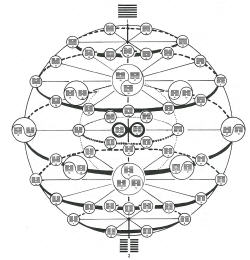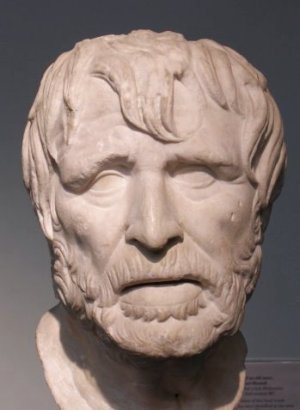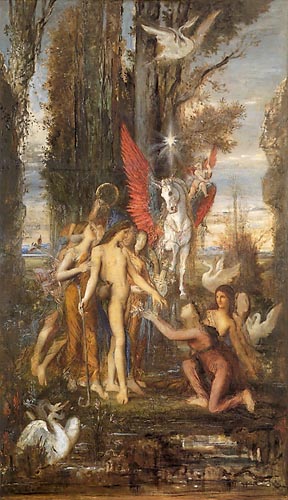|
- Olympic Tarot: Trionfi.com, having concentrated in the last two years on Tarot history in 15th century, will change or at least expand its focus. The new theme will be for specific reasons the "Theogony" of Hesiod. Other aspects of the new studies will touch the Sepher Yetzirah and the Chinese I-Ching.
Autorbis, main writer at Trionfi.com, explains:
"Our theme is the origin of Tarot, but actually the definition of the word Tarot is rather fluently interpreted in history. The word is proven in the meantime for the year 1505 as relating to playing cards (we reported March 2004), but actually the objects, which had been called Tarot then, existed before this date, probably runnning under the name "Trionfi". However, our researches have shown, that the name "Trionfi" was applied to a great variety of decks, using different motifs and having different number of cards, just according to the creative impulses of the deck designers. So the Michelino deck was called by Jacopo Antonio Marcello in 1449 a "ludus triumphorum", and it has not the common 4x14+22-Tarot-structure and not the common Tarot motifs, but 16 trump cards and Greek gods as motifs. As one might now define, that "Tarot" is simply that, what 15th century man might have created in his phantasy, wer're up to study the interests of this time ... and one specific and important theme was to understand Greek mythology, it was a new field to the Italian people and as theme it dominated the triumphal processions in 15th and 16th century, which gave the name Trionfi to the card game.
Can we now reduce the word "Tarot" to series of motifs, that appear on playing cards? Our studies lead to the conclusion, that all motifs on the Tarot cards appear earlier in other productions of art. If we would find for instance a series of book-paintings of 14th century, which contain Fool, Magician, Papessa and all other motifs of the later Tarot, we wouldn't hesitate to explain, that this is "Tarot". Although this book-painting doesn't exist, and we've reason enough to assume, that it never existed, cause Tarot developed in small steps and with iconographical changes in 15th century, Tarot is not limited to that, what appears on playing-cards. So what is Tarot then ... In our researches about Tarot in 15th century we do not perceive "wise men, who made the Tarot", as it once was talked of in mystery-seeking Tarot-circles of 19th century, but lucky court communities of young persons creatively experimenting with a new media, playing-cards. But again, these young communities were not completely uninspired, they also searched the wisdom of the old and they tried to find it in the then new imported texts around Greek mythology ... they reproduced their findings in art and poetry and with that they accompanied the wonder of renaissance, a revolution of culture and art. Did they reach the mystery they searched for? We've our doubts about that ... they stumbled around and made some experiments, that's all. The various results which reached their appearance on playing-card decks as socalled "Tarot cards" are childish and innocent, not very impressive - in our eyes, other examples of art seem to go deeper.
But they searched a mystery in the writings of the old ... We think, this mystery, that they searched, is reachable - or at least researchable - nowadays much better than in the situation of 15th century (and btw. also much better than in the situation of the Golden Dawn, who researched 100 years before internet)."
-
The mystery of Greek mythology - that was the theme of these 15th century thinkers - is in our opinion described in hidden form in the Theogony of Hesiod, a text, which contains some mathematical schemes which show a strong relationship to schemes used in Sepher Yetzirah and the Chinese I-Ching. All 3 texts have considerable age (I-Ching originated from around 1100 BC, the Theogony from around 700, the Sepher Yetzirah is younger - estimated 100 - 500 AD - but seems to relate to schemes, which already existed before 1000 BC. All 3 texts had been eminent influential on religious and philosophical minds in the past and reached a huge number of commentators in their culture.
The mathematical mystery of all 3 texts is very simple: It's the binary code with 6 bits. Each of the 3 mentioned texts has its specific form to deal with it, but all belong to the category "global world-explanation" or world-genesis" - in the mind of some people some 1000s years ago.
- The I-Ching very openly works with 2 basic trigrams consisting of 3 yang- and 3 yin-lines. At a second stage 6 yang- and 6 yin-lines are used (together 18 elements). The 6 Yang and 6Yin-lines form a mathematical body with 64 elements called hexagrams. The main concern of I-Ching is divination.
- The Sepher Yetzirah hides its mathematical source, but formulates "32 ways of wisdom" (which are the 64 elements of the Chinese system, but in the Sepher Yetzirah the complementary hexagram-pairs are united and so the group is reduced to 32 elements). More openly is traded the cube of space with 3 dimensions and 6 directions, which automatically leads to the same mathematical body as the I-Ching (and Hesiod) uses. The main concern of Sepher-Yetzirah is to explain, how God created the world with the 32 ways of wisdom. The author involves the 22 letters of Hebrew alphabet and the 10 first numbers to hide his system.
(Aryeh Kaplan, author of a reknown kabbalistic interpretation of the Sepher Yetzirah, believes, that the "32 ways correspond to the number of apexes on a five dimensional hupercube" (p.10). - this is completely wrong and misleading. The 32 ways correspond to the 6-dimensional hypercube, (not the 5-dimensional hypercube), but in a very specific way. The number 64 is not mentioned in Sepher Yetzirah, but in the Bahir, another prekabbalistical text, translated also by Kaplan, p 35. There they are called "the 64 Forms").
- Hesiod also presented his mathematical idea in a disguised form. The 3 Yang- and 3 Yin-lines of the trigram-level are hidden behind 3 "one-eyed" cyclopes and 3 "100-armed" Hecatonchiren, the 6 Yang- and 6-Yin-lines as 6 male and 6 female Titans, forming together the 18 children of Uranos ("heaven") and Gaia ("earth"). The 64 is usually disguised as "49 + 1"-element, which appears in various contexts.
Hesiod's use of the scheme becomes very complex (much more complex than I-Ching and Sepher Yetzirah), as the mathematical riddle (plus other content) is repeated and varied on various levels of the story, especially it becomes complex, as other later poets seem to have accepted the scheme and contributed to it with further details of the story.
Own articles
Material in the Web
Hesiod, Material to the Theogony and Mythology
Sepher Yetzirah (was already involved in Tarot, when in 19th century Eliphas Levi and Golden Dawn tried to relate Tarot to Kabbala)
I-Ching
- How the themes will start? Well, that's a little personal .... we don't know it. It is a gigantical attempt. - especially the handling of the vast mythological material - and we don't know how to get the time for it. The material is more or less all from autorbis' earlier studies. A lot of things stayed uncompleted then and need further research to reach some quality and security in the conclusions. And still we've a lot to finish with the "Tarot-in-15th-century"-stuff.
But it's the right time to announce it. Olympia in Athen 2004. In 4 years it will be in China. And this specific study will tell, that there is more than one relationship between Greek mythology and Chinese art of divination. So we were in a conflict, what to do ... and had some discussion in our small publishing community. Stupid me suggested, that I would write some didactical articles to introduce the theme ... autorbis, who knows the stuff a little better than me, sneered and said: "Then do it ...." and now I know, why. It's a djungle and my incomplete representations wander through ... ah, forget it. You can read these explorations ... under the point "Olympic Game" ... half-edited, not really ready, and of course, nobody tells you, that you've to take everything serious, still there are some faults and all it's up to your own responsibility, what you believe or not. And I don't know how this will proceed... And now leave me alone a little bit.
- Neo-Pythagorism: Alain Bougearel has published on a French webpage his take on neo-pythagorism and Tarot. He mainly focuses on the 78- Tarot-structure with 78 cards (which he dates on circa 1461 or later according to the evidence of the Boiardo deck) and the possibilty of a Byzantium influence relative to the fact that the structure 22 + 56 became finally dominant. A discussion takes place at History Forum of Aeclectic.net.
- The TarotL History Fact Sheet found a translation in French by Laurent Edouard and it's publication on the web by the Journal de demain with Alain Bougearel's comments relative to the datation of the origin of the 22+56 structure (circa 1461 or later). An important event for the French lovers of Tarot : a new perspective different of the Dummet, Decker-Depaulis thesis of the 1451 Visconti-Sforza deck and the "traditional" thesis, that Tarot originated with 22 trumps.
- John Mc Leod at pagat.com has published a good overview page with lots of playing card links.
- Painkiller, a computergame, involves Tarot cards as element in the game. "Throughout the levels you can enhance your abilities with Black Tarot Cards. These cards are hidden in the level or are achieved by completing the level in a certain way. To use these cards you must have enough gold coins, you collect coins by breaking the vases, crates, and other destructible items in the game. These Tarot cards are an excellent enhancement ... " the description says.
- Older Novelties at Trionfi.com:
- Timeline (June 2004)
- already mentioned in Tarot News June 2004 - but worth a rememberance with many hidden corners
- About 80 Fortune telling decks (June 2004)
- a collection of alternative non-Tarot divination, worth to be studied a little bit. The playing card world knows more than only Tarot.
- Updated: the article Oldest Tarotcards (June 2004)
- considerably enlarged. Of special worth is the new biography of Decembrio - Compare Motifs (July 2004)
- of special worth, when you're interested to compare two cards of the same or a different deck. A good tool, when you're interested to study the properties of cards in detail.

(composed by Huck Meyer)
|

"In the mid-eighth century, a sailor settled at Ascra in Boeotia, where his son started to write a poem on farming, Works and days. The poet is usually called Hesiod, after another Boeotian poet, who had composed a primitive but systematic account of the history of the gods, full of dark forces, deities, and violence: the Theogony. The ancients believed that both poems were written by the same man, but many modern classicists agree that the author of the Works and days was influenced by Homer, whereas the author of the Theogony, Hesiod, seems to have been Homer's contemporary. Both works are fascinating: the younger because of its superior style, the other because it offers an important introduction to Greek mythology."
From "Greek Authors"

Gustav Moreaux (1826 - 1898), "Hesiod"
|

